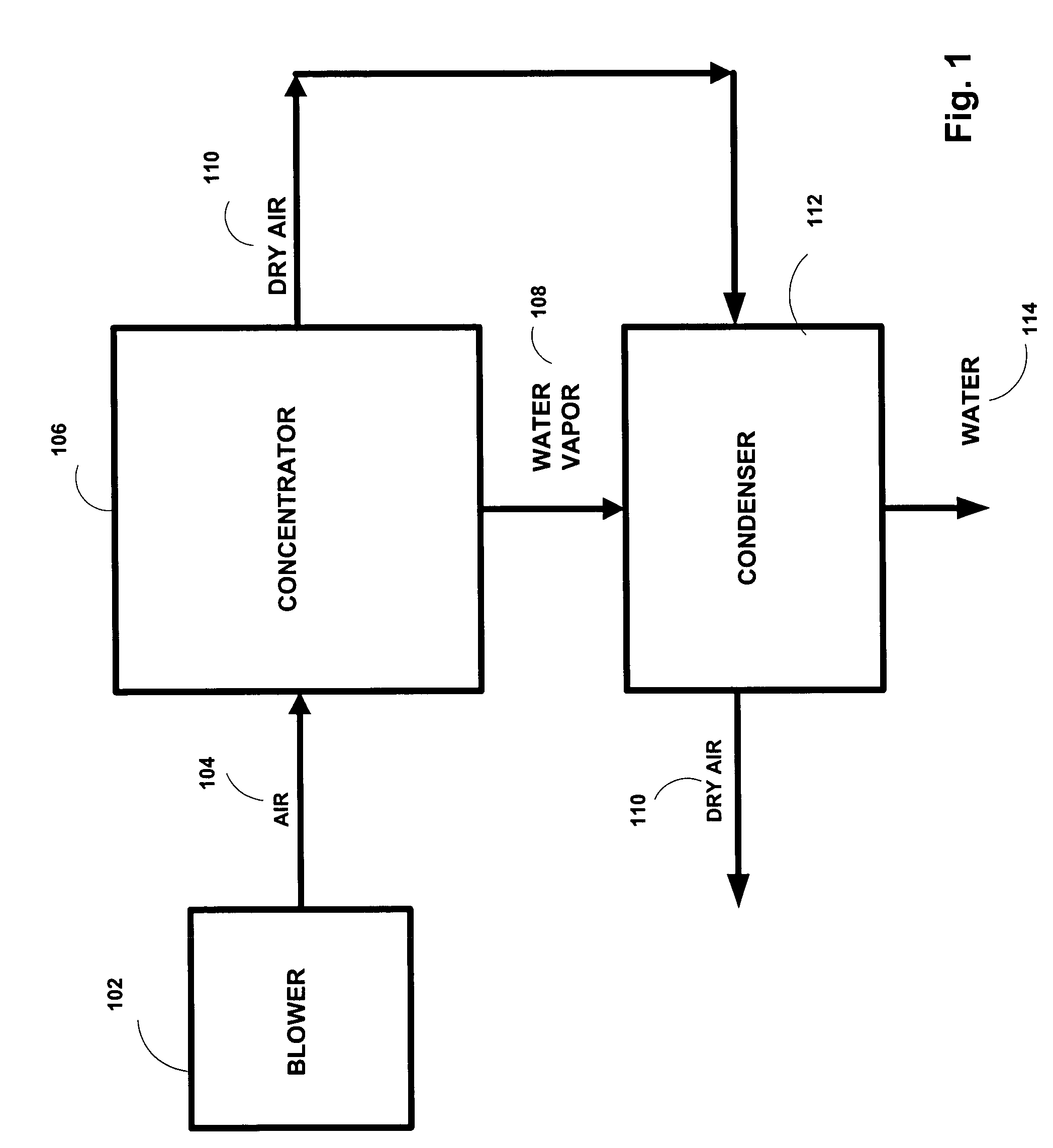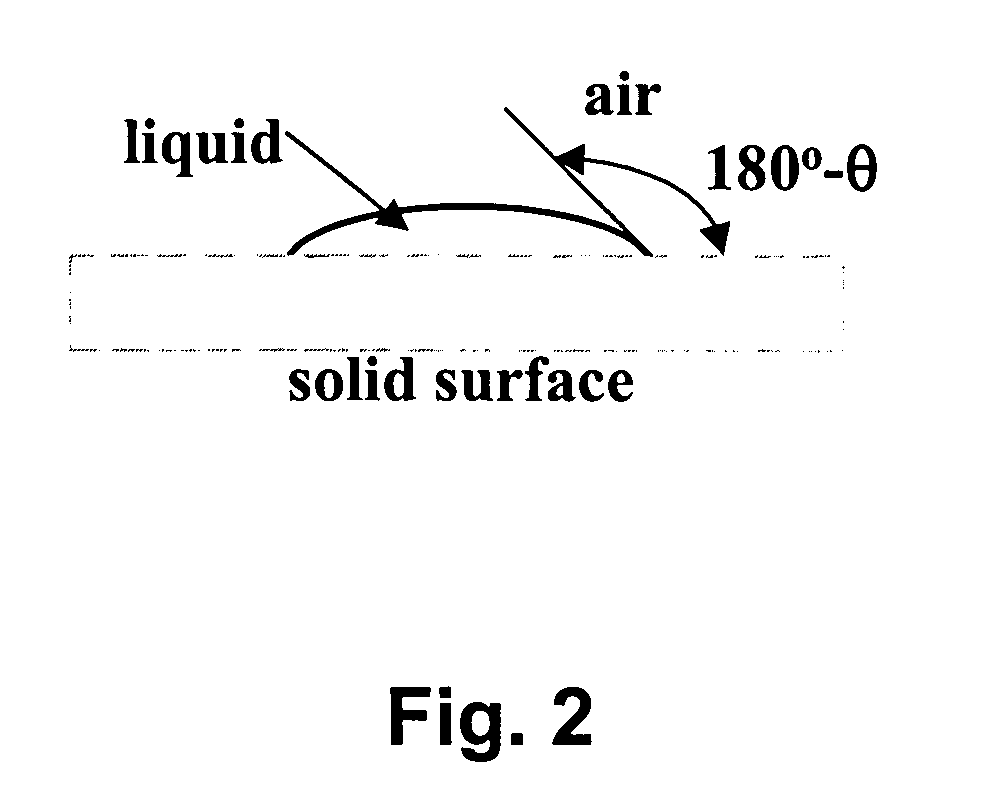Production of drinking water from air
a technology of air production and water extraction, applied in the direction of liquid degasification, heating types, separation processes, etc., can solve the problems of large required equipment, large energy consumption, and inability to guarantee the existence of liquid water of any kind,
- Summary
- Abstract
- Description
- Claims
- Application Information
AI Technical Summary
Problems solved by technology
Method used
Image
Examples
example 1
[0057]Partially hydrophobic activated carbon particles having a high surface area (SA- 1500, MeadWestvaco Corporation, Stamford, Conn.) are attached to opposing sides of a 316 grade stainless steel sheet (10 cm×15 cm×250 μm) using a phenolic binder (Resin 12874, Rutgers-Plenco LLC, Sheboygan, Wis.) that is previously combined with carbon black (XC-72, Cabot Corporation, Boston, Mass.) to make the binder electrically conductive. To attach the activated carbon particles to the stainless steel sheet, the binder is applied to the sheet by dip coating and the particles are adhered to the coated sheet. The sheet and binder are then thermally cured at 150° C. for one minute.
[0058]Next, the internal pores of the hydrophobic activated carbon particles are coated with a mixture of water and a surfactant, namely poly(propylene glycol) mono butyl ether having the general formula CH3(CH2)3[OCH2CH(CH3)]nOH and a molecular weight of 1,000 (CAS #9003-13-8, Aldrich #43,811-1, Sigma-Aldrich, Co., St....
example 2
[0059]Partially hydrophobic activated carbon particles having a high surface area (WVA-1500, MeadWestvaco Corporation) are attached to opposing sides of a 316 grade stainless steel sheet (10 cm×15 cm×250 μm) using a phenolic binder (Resin 12874, Rutgers-Plenco LLC) previously combined with carbon black (XC-72, Cabot Corporation) to make the binder electrically conductive. To attach the activated carbon particles to the stainless sheet, the binder is applied to the sheet by dip coating and the particles are adhered to the coated sheet. The sheet and binder are then thermally cured at 150° C. for one minute.
[0060]Next, the internal pores of the hydrophobic activated carbon particles are coated with water and a surfactant, namely tri(propylene glycol) butyl ether having the general formula C4H9O[CH2 CH(CH3)O]3H and a molecular weight of 248.4 (CAS #55934-93-5, Aldrich #48,422-9). The ratio of tri(propylene glycol) butyl ether to activated carbon is 1:10 by mass. The sheet and water-gly...
example 3
[0061]Partially hydrophobic activated carbon particles having a high surface area (SA-1500, MeadWestvaco Corporation) are mixed with a microfine, low-density thermoplastic binder (Microthene FN 510-00, Equistar Chemicals LP, Houston, Tex.) at a mass ratio of 4:1, respectively. The mixture is applied to opposing sides of a 316 grade stainless steel sheet (10 cm×15 cm×250 μm) The sheet and binder are thermally cured at 110° C. for five minutes.
[0062]Next, the internal pores of the hydrophobic carbon particles are coated with water and a surfactant, namely poly(propylene glycol) mono butyl ether having a molecular weight of 1,000 (CAS #9003-13-8, Aldrich #43,811-1). The ratio of poly(propylene glycol) mono butyl ether to activated carbon is 1:5 by mass. The sheet and water-glycol solution is then dried at 110° C.
PUM
| Property | Measurement | Unit |
|---|---|---|
| pore diameter | aaaaa | aaaaa |
| pore diameter | aaaaa | aaaaa |
| contact angle | aaaaa | aaaaa |
Abstract
Description
Claims
Application Information
 Login to View More
Login to View More - R&D
- Intellectual Property
- Life Sciences
- Materials
- Tech Scout
- Unparalleled Data Quality
- Higher Quality Content
- 60% Fewer Hallucinations
Browse by: Latest US Patents, China's latest patents, Technical Efficacy Thesaurus, Application Domain, Technology Topic, Popular Technical Reports.
© 2025 PatSnap. All rights reserved.Legal|Privacy policy|Modern Slavery Act Transparency Statement|Sitemap|About US| Contact US: help@patsnap.com



